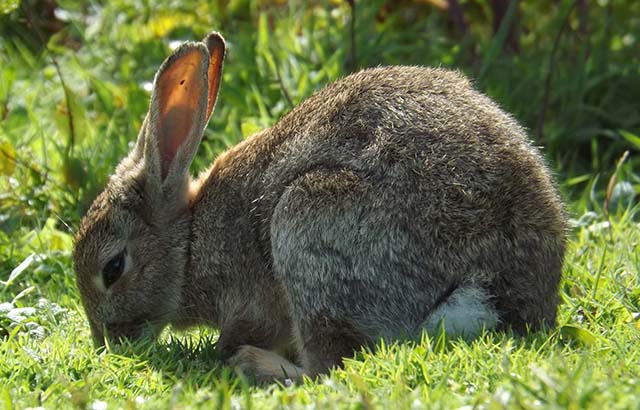Rabbits like to eat plants with lots of DNA
Rabbits prefer to eat plants with plenty of DNA, according to a new study by Queen Mary University of London and Royal Botanic Gardens, Kew.

Rabbit in Skomer, Wales, which is a similar habitat to the experimental plots. Credit: Dr Lizzie Wilberforce
The researchers also found that it is the opposite for invertebrates, like snails and insects, as they prefer to eat plants with much less DNA.
Many factors influence what herbivores such as rabbits eat but the role of genome size, which is the amount of DNA in an organism’s cells, in herbivore-plant interaction was unknown.
In this study, published in Proceedings of the Royal Society B, the researchers suggest that genome size should be used as a new measure to improve ecological models which are designed to predict how plant communities will respond to ecological change, caused by climate or altered land use for example.
However, while the results suggest which plants rabbits and invertebrates prefer, they could also show that these plants are simply recovering more slowly after being eaten.
Genome size matters
Professor Andrew Leitch, joint-lead author of the study from Queen Mary's School of Biological and Chemical Sciences, said: “We demonstrate that genome size plays a role in influencing plant–herbivore interactions, and suggest the inclusion of genome size in ecological models has the potential to expand our understanding of plant productivity and community ecology under nutrient and herbivore stress.”
The study was carried out on grassland west of London, where herbivores have been excluded for eight years.
The researchers analysed plots that were then grazed by rabbits or grazed by invertebrates to determine which plants grew the most. They found that plants responded in different ways, depending on the herbivore.
It is thought that rabbits may favour plant species with large genomes because they are more nutritious, given that a plant genome is a rich package of proteins and nucleic acids needed by animals to build their own cells.
Invertebrates meanwhile are likely to have established themselves as specialists on plant species with small genomes because there are more available to them.
Plant genome sizes can vary hugely, with the largest at least 2,400 times bigger than the smallest. This has an impact on how and where plants can live and this study shows that species are differentially impacted by different types of herbivores depending on how much DNA is in each of their cells.
Dr Ilia Leitch, from Royal Botanic Gardens, Kew, added: “We argue that genome size needs to be considered in ecological models that are describing ecological processes. The functionality of these ecological models is essential if we are to establish good policy to mitigate against the negative effects of climate change, changing land use, eutrophication of our environment and to conserve our endangered species.”
More information:
- Research paper: ‘Interactions between plant genome size, nutrients and herbivory by rabbits, molluscs and insects on a temperate grassland. Maite S. Guignard, Michael J. Crawley, Dasha Kovalenko, Richard A. Nichols, Mark Trimmer, Andrew R. Leitch and Ilia J. Leitch. Proceedings of the Royal Society B.
- Study Biology at Queen Mary
Related items

12 August 2025

4 August 2025
For media information, contact:
